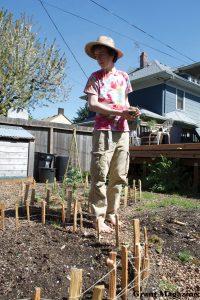Grant junior Cole Hepner crouches down to pluck a tiny plant from a grimy patch of ground in a convenience store parking lot on the corner of Northeast 33rd Avenue and Killingsworth Street. It’s a medicinal herb he identifies as the Oregon Plantain. “When I’m walking around town with my friends or for some other reason, I will constantly keep my eye out, and if I spot something I recognize, I grab it,” he says.
Hepner, 17, usually dries the plants and puts them into glass mason jars sitting on a shelf in his bedroom. Underneath the herb collection is a set of books. “Backyard Foraging,” “Native American Healing Secrets” and “How To Stay Alive In The Woods” are a few of his favorites. Hepner strives to live a self-sufficient lifestyle.
He grows his own plants, makes his own tools and serves as his own guide. He isn’t involved in any clubs or sports at Grant.
“There’s not exactly a club I can go to for my interests. A lot of high schoolers haven’t the first clue about gardening or woodworking.” -Cole Hepner
Hepner’s passion grew partly due to his grandfather, who works for IBM but clears trails and builds swimming holes in his free time. Hepner has visited him at his home in Mt. Madonna since he was 6 years old. “He owns property with woods and I remember hiking there for hours,” Hepner says. “I would make mental notes of all the plants I saw, and go back to my cousins and show them what I had found.”
If you walk into Hepner’s kitchen today, you might smell homemade soap cooking in his oven. Tea tree, oatmeal, coconut and beer-scented bars are some of Hepner’s latest handiwork.
Go into his backyard and you’ll get a better picture of who he is. Once you walk past the woodworking station on a scrap wood-littered porch, you’ll be in Hepner’s garden. Twisted vegetable plants are pinned in by makeshift fences – uneven wooden stakes tied together with twine.
This summer, Hepner hopes to attend a construction camp through the Pacific Northwest Carpenters Institute. He plans on using what he learns there to build a boat and float down the Willamette River.
Eventually, Hepner plans on building his own house and living off the land. He describes it as a “minimalistic” lifestyle. “Somewhere in Oregon, hopefully in the woods,” he says. “With some goats, a garden and some toilet paper.” ♦
As a child, Hepner wasn’t afraid to get dirty. “He knows who he is,” says his mom, Karen Wood. “That’s never been an issue. It’s really cool and fascinating to be his mom. He’s just got this drive in him to be creative.”
In the parking lot of a convenience store, Hepner inspects a plant he recognizes – the Oregon Plantain.
Hepner’s younger brother, Aedan, a Grant freshman, looks up to his brother’s unusual lifestyle. Hepner’s girlfriend, Savanna Avila-Crump, admires his drive. “If he gets an idea in his head, he’s very motivated and makes it happen,” she says.
An iron knife that Hepner forged in a recent blacksmithing class sits on his windowsill.
Hepner has been making soap all year, building up to the trade show for his marketing class. He plans on selling them as “Roarin’ Goat Soaps”. Here is how you can make it for yourself:
11 fl. oz. coconut oil
18 fl. oz. olive oil
8.5 fl. oz. goat’s milk
100 g pure sodium hydroxide
1. Mix coconut oil and olive oil in a large bowl.
2. In a separate container, mix goat’s milk and sodium hydroxide. Mix until sodium hydroxide is completely dissolved and the solution is a burnt orange color.
3. Add solution to the bowl of oil. Stir until the mixture is thick and creamy, almost the consistency of pudding.
4. Add 1 cup finely ground charcoal. (Can substitute tea leaves or whole oats.)
5. Stir until charcoal is evenly distributed.
6. Pour mixture into a metal mold, such as a muffin tin.
7. Bake on your oven’s lowest setting for 20 minutes or until firm.
8. Let the soap cool off at room temperature and use.















































